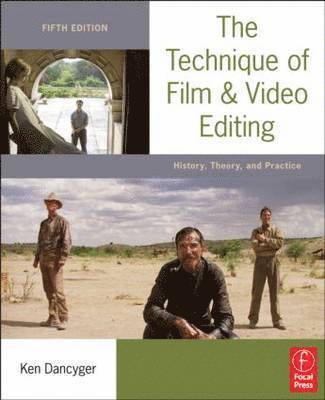
- Format
- Häftad (Paperback)
- Språk
- Engelska
- Antal sidor
- 459
- Utgivningsdatum
- 2010-12-07
- Upplaga
- 5 Rev ed
- Förlag
- FOCAL PRESS
- Illustratör/Fotograf
- Approx 200 illustrations
- Illustrationer
- Approx. 200 illustrations
- Dimensioner
- 228 x 177 x 19 mm
- Vikt
- Antal komponenter
- 1
- Komponenter
- 3:B&W 7.5 x 9.25 in or 235 x 191 mm Perfect Bound on White w/Gloss Lam
- ISBN
- 9780240813974
- 997 g
The Technique of Film and Video Editing: History, Theory, and Practices 5th Revised Edition
Kundrecensioner
Fler böcker av Ken Dancyger
-
The Technique of Film and Video Editing
Ken Dancyger
-
Writing the Short Film 3rd Edition
Patricia Cooper, Ken Dancyger
-
Storytelling for Film and Television
Ken Dancyger
-
Alternative Scriptwriting
Ken Dancyger, Jessie Keyt, Jeff Rush
Recensioner i media
"From D.W. Griffith to MTV, from silent movies to action films, Dancyger explores not only history, techniques, and the social aspects of film and video, but he also looks at how technology has affected film and video making and editing. This isn't a quick read but definitely worthwhile if you want to gain an understanding of what it takes to be an excellent director and editor." -Theano Nikitas, Camcorder & ComputerVideo Praise for previous editions: "Ken's additions to his book show all of us who love and study the craft of editing, a real understanding of the importance and stimulating impact editing has in helping tell a story, create mood, and shape characters." --Sam Pollard, film editor, Girl 6, Clockers, Mo Better Blues "Dancyger's book is an excellent introduction to the art of manipulating moving pictures and sound for students, amateurs, hobbiests and professionals alike." - Videomaker "...a thoroughly "reader friendly" introduction and survey of proven editing techniques and how those techniques influence the editing process..." - The Bookwatch, Sept. 2006"
Övrig information
Ken Dancyger is the author of numerous books on screenwriting, editing, and production. He conducts screenwriting forums and workshops in North America, Europe, and Asia. A past chair of Undergraduate studies in the Department of Film and Television at NYU, he is currently Professor of Film and Television at the Tisch School of the Arts at New York University.
Innehållsförteckning
Introduction; The Silent Period; The Early Sound Film; The Influence of the Documentary; The Influence of the Popular Arts; Editors Who Became Directors; Experiments in Editing: Alfred Hitchcock; New Technologies; International Advances; The Influence of Television and Theatre; New Challenges to Filmic Narrative Conventions; The MTV Influence on Editing I; The MTV Influence on Editing II; The Influence of Psychoanalytic Ideas on Editing; The Appropriation of Style I : Imitation and Innovation; The Appropriate of Style II: Limitation and Innovation; The Appropriation of Style III Digital Reality; Editing for Narrative Clarity; Editing for Dramatic Emphasis; Editing for Aesthetics; Editing for Subtext; Action; Dialogue; Comedy; Documentary; Imaginative Documentary; Innovations in Documentary; More Innovations in Documentary; Ideas and Sound; The Picture Edit and Continuity; The Picture Edit and Pace; Changes in Pace; The Sound Edit and Clarity; The Sound Edit and Creative Sound; Innovations in the Use of Sound; Nonlinear Editing and Digital Technology I; Nonlinear Editing and Digital Technology II; Altering Reality Using Digital Visuals and Sound; Conclusion
Du kanske gillar
-
The Contrarian
Max Chafkin
Häftad -
Big Cloud
Camille Seaman
Inbunden
